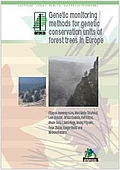Genetic monitoring

Genetic diversity is an essential element of tree species' ability to adaptat to climate change and other environmental changes. While several schemes have been set up during the past 30 years to monitor the health and biodiversity of forests in Europe, none of them expressly collects information about status and trends of genetic diversity. EUFORGEN has previously emphasized the importance of genetic monitoring and more recently, the Steering Committee established a working group to review genetic monitoring methods and to propose options for creating a pan-European genetic monitoring system for genetic conservation units of forest trees.
The working group concluded that a system for genetic monitoring of the genetic conservation units would be an invaluable tool for conservation of forest genetic resources and for sustainable forest management. The group recognised that the intent of genetic monitoring efforts is expanding, from the temporal assessment of genetic diversity and the processes that maintain it, to the evaluation and conservation of the adaptive potential of genetic diversity. This kind of monitoring is important because it offers an early warning system that would increase the chances of implementing actions to reduce potentially harmful effects, especially under rapidly changing environmental conditions.
The working group assessed existing practices and as a result, it suggests specific approaches to:
- Identify regions for genetic monitoring
- Identify units for genetic monitoring within these regions
- Design genetic monitoring plots in the selected units
- Select indicators and verifiers for genetic monitoring
Implementation of these recommendations will result in a comprehensive and unified scheme, unique for Europe and of global significance.
'Forest in the lab'
What is forest genetic monitoring? How can it be applied throughout Europe? In this video, Bernd Degen, head of Forest Genetics Institute, vTI (Germany) responds to these questions and walks us through the laboratories of the Thünen Institute where tree samples are examined.
 | Genetic monitoring methods for genetic conservation units of forest trees in EuropeGenetic diversity is an essential element of tree species adaptation to climate change and other… |
Download |
